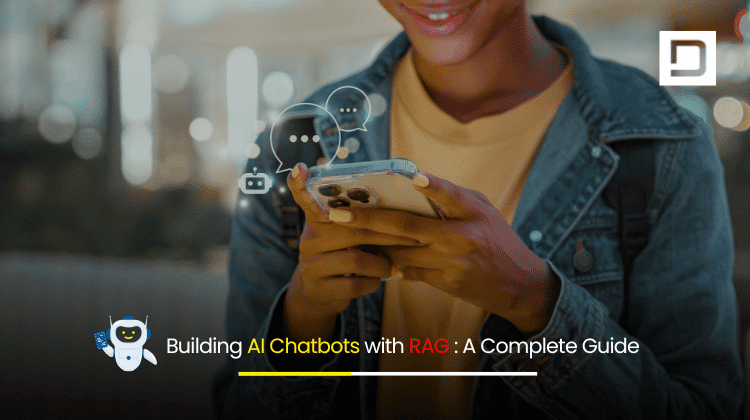Building AI Chatbots with RAG: A Complete Guide
In today’s digital world, businesses are increasingly relying on Artificial Intelligence (AI) to enhance their customer experiences. Among the most effective AI tools for customer engagement is the chatbot. A chatbot powered by AI can seamlessly handle customer queries, solve problems, and provide assistance 24/7. However, building an efficient and effective AI chatbot requires a structured approach, and one of the most effective strategies for achieving this is the use of RAG (Retrieval-Augmented Generation).
In this guide, we will explore what RAG is, how it works, and why it is an essential tool for building smarter, more efficient AI chatbots. We will also discuss how businesses can implement RAG-based AI chatbots to improve customer service and user engagement.
What is Retrieval-Augmented Generation (RAG)?
RAG is an advanced AI technique that combines retrieval-based methods and generation-based methods to enhance the capabilities of chatbots. Traditionally, chatbots use either a retrieval-based approach or a generation-based approach:
- Retrieval-based method: In this approach, the chatbot pulls relevant responses from a pre-defined set of responses based on user input. The focus is on retrieving the most relevant information from a dataset or knowledge base.
- Generation-based method: Here, the chatbot generates a response dynamically, leveraging deep learning models such as transformers (e.g., GPT-3). These models are capable of producing fluent, contextually appropriate responses, but they may not always retrieve factual information accurately.
RAG combines the strengths of both methods to provide a more powerful chatbot experience. In this model, the chatbot first retrieves relevant information from an external knowledge base and then generates a coherent response using that information. This allows the chatbot to not only provide accurate and contextually relevant answers but also to engage in more complex conversations.
Why Use RAG for AI Chatbots?
There are several reasons why businesses should consider using RAG for their AI chatbots:
- Improved Accuracy: RAG’s retrieval-based component ensures that the chatbot can pull information from a trusted and relevant knowledge base. This results in more accurate and factually correct responses compared to traditional generation-only models.
- Context Awareness: With RAG, chatbots can maintain better context awareness throughout a conversation. Since the model retrieves relevant data from external sources, it is less likely to generate responses that are out of context or irrelevant.
- Scalability: RAG-based systems can scale more effectively than pure generative models. As new information is added to the knowledge base, the chatbot’s ability to retrieve and provide accurate answers improves over time.
- Faster Response Time: By retrieving information from a pre-existing database, RAG-based chatbots can provide faster responses compared to traditional models, which often need to generate answers from scratch.
- Better User Experience: RAG helps deliver responses that are not only accurate but also contextually appropriate, leading to a smoother, more satisfying user experience. Users are more likely to trust and engage with a chatbot that can deliver consistent and reliable information.
Key Components of a RAG-Based Chatbot
To understand how RAG works, it’s essential to break down its key components:
- Retrieval Model: This part of the chatbot searches a large set of documents or databases for information that is relevant to the user’s query. The retrieval model can be powered by technologies such as BM25, TF-IDF, or more advanced methods like dense retrieval using embeddings (e.g., BERT, Sentence-BERT).
- Knowledge Base: The knowledge base is the collection of data or documents that the chatbot uses to retrieve relevant information. This can include a variety of sources, such as:
- FAQs: Frequently asked questions and their corresponding answers.
- Product Documentation: Manuals, guides, or any form of product-related content.
- Customer Support Data: Chat logs, support tickets, and troubleshooting steps.
- Public Databases: External knowledge sources like Wikipedia or specialized industry-specific databases.
- Generation Model: After retrieving relevant information, the chatbot’s generation model (e.g., GPT-3 or T5) constructs a natural-sounding response based on the retrieved data. The generation model ensures that the response is not just a direct copy-paste of the retrieved data but is rephrased in a human-readable and conversational tone.
- Interaction Layer: The final layer of the RAG-based chatbot involves interaction with the user. This layer ensures that the chatbot’s responses are delivered seamlessly in a chat interface. It can handle multiple turns of conversation, maintain context, and incorporate feedback from the user.
Steps to Build an AI Chatbot with RAG
Now that we understand the components of RAG, let’s look at the step-by-step process for building an AI chatbot using Retrieval-Augmented Generation.

Step 1: Define the Problem and Use Case
Before starting with the development of the chatbot, it’s important to define the problem you’re trying to solve. Identify your target audience, the common queries or tasks your chatbot will handle, and the type of data the chatbot will require to perform its job effectively.
For example, a customer support chatbot for an e-commerce platform may need to retrieve data from product catalogs, order history, and support ticket information. On the other hand, a healthcare chatbot might require access to medical databases and guidelines.
Step 2: Build or Integrate the Retrieval Model
The retrieval component is crucial for RAG, as it helps your chatbot access relevant information quickly. You can either build your own retrieval model or integrate an existing one. Here are the key steps involved in this phase:
- Data Collection: Collect all the relevant data that your chatbot will retrieve from. This can include product descriptions, help articles, customer service logs, etc.
- Indexing the Data: Once the data is collected, index it so that it can be efficiently searched. Technologies like Elasticsearch or FAISS (Facebook AI Similarity Search) can be used to index the data and retrieve relevant documents efficiently.
- Training the Retrieval Model: If you’re using a deep learning-based retrieval model, such as BERT or T5, you’ll need to fine-tune it on your specific dataset. This will help the model better understand the context of your data and improve the quality of the retrieved responses.
- Implementing Dense Retrieval: For more sophisticated retrieval, consider implementing dense retrieval techniques, where text embeddings are used to search through the knowledge base. Tools like Hugging Face Transformers can help you implement dense retrieval.
Step 3: Integrate the Generation Model
After retrieving relevant information, the next step is to integrate the generation model. This part is responsible for creating a response that sounds natural and flows smoothly in the conversation. You can choose from several pre-trained models for this task:
- GPT-3: Known for its ability to generate human-like text and engage in conversations, GPT-3 can be used to generate responses from the retrieved data.
- T5: T5 (Text-to-Text Transfer Transformer) is another popular model that can be used to generate responses.
- BART: BART (Bidirectional and Auto-Regressive Transformers) is effective at generating text from structured data.
You can fine-tune these models on your dataset to generate responses that are not only contextually relevant but also coherent and engaging.
Step 4: Design the User Interface (UI)
A user-friendly interface is critical for the success of your chatbot. The user interface (UI) is where users will interact with the chatbot. Depending on the platform (website, mobile app, or messaging app), you will need to design an interface that facilitates easy communication.
Make sure to:
- Provide quick reply buttons for faster interactions.
- Ensure that the chatbot’s responses are clear and easy to understand.
- Design a conversational flow that mimics human interaction.
Step 5: Test the Chatbot
Once your RAG-based AI chatbot is developed, it’s time to test it. You should test for the following:
- Accuracy: Does the chatbot retrieve the correct information? Are the generated responses relevant to the query?
- Response Time: Does the chatbot respond quickly to user queries?
- User Satisfaction: Are users satisfied with the responses and the overall interaction?
Testing should be done in multiple stages, from unit testing the individual components to beta testing with real users. Gather feedback, iterate, and refine the system.
Step 6: Deployment and Monitoring
Once you’ve tested your RAG-based AI chatbot, it’s time to deploy it. Choose the appropriate platform for deployment based on your target audience. This could be on your website, mobile app, or third-party messaging platforms such as Facebook Messenger or WhatsApp.
After deployment, it’s essential to monitor the chatbot’s performance continuously. Use analytics tools to track user interactions, response accuracy, and areas where the chatbot might be failing to deliver useful responses.

Best Practices for Building a Successful RAG-Based Chatbot
- Keep the Knowledge Base Updated: A chatbot’s performance is directly linked to the quality and relevancy of the knowledge base it retrieves information from. Regularly update the knowledge base to ensure that the chatbot can access the most current and accurate information.
- Maintain Context in Conversations: Ensure that your RAG chatbot is capable of maintaining context over long conversations. This will help avoid irrelevant or inconsistent responses during multi-turn interactions.
- Personalize User Interactions: By leveraging user data, such as previous interactions or preferences, you can personalize responses and create a more engaging experience.
- Handle Unexpected Queries: Sometimes, users may ask questions that fall outside the scope of your chatbot’s knowledge base. Ensure that the chatbot has fallback mechanisms in place, such as handing off the conversation to a human agent.
- Implement User Feedback Mechanisms: Allow users to rate the chatbot’s responses or provide feedback. This will help you continually improve the chatbot’s performance.
Conclusion
Building AI chatbots with RAG (Retrieval-Augmented Generation) is an innovative and effective approach to creating smarter, more efficient solutions for customer engagement. By combining retrieval-based and generation-based models, RAG enables chatbots to provide highly accurate, context-aware, and natural responses that improve user experiences and drive business growth. Whether you’re looking to enhance customer support, improve user interaction, or build an entirely new AI chatbot, implementing RAG can take your chatbot’s capabilities to the next level.
At Depex Technologies, we specialize in delivering advanced AI solutions tailored to your unique business needs. If you’re looking to build a custom RAG-powered AI chatbot or need a dedicated developer or team to handle your AI and chatbot development projects, we’re here to help. Our experienced developers and engineers can work with you at every step, from ideation to implementation, ensuring that your chatbot is as efficient and user-friendly as possible.
Reach out to Depex Technologies today to discuss your project requirements, and let us provide you with the expertise you need to bring your AI chatbot vision to life. Whether you need a single developer or a full team for any of your AI or software development needs, we’re ready to help you achieve success.






